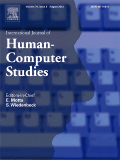
INTERNATIONAL JOURNAL OF HUMAN-COMPUTER STUDIES
Scope & Guideline
Exploring the Nexus of Humanity and Technology
Introduction
Aims and Scopes
- Human-Computer Interaction Research:
The journal emphasizes rigorous empirical studies that investigate how users interact with computer systems, including usability, user experience, and interaction design methodologies. - Emerging Technologies and Interfaces:
Research focusing on novel interfaces and technologies, such as virtual reality (VR), augmented reality (AR), and artificial intelligence (AI), is a significant aspect of the journal, examining their implications for user interaction. - User-Centered Design and Evaluation:
A strong focus on user-centered design principles and evaluation techniques, ensuring that technological innovations are developed with the needs and capabilities of users in mind. - Social and Ethical Implications of Technology:
The journal also addresses the broader social and ethical implications of technology adoption, particularly concerning privacy, trust, and the impact on human behavior and society. - Interdisciplinary Approaches to HCI:
Encouraging interdisciplinary research that combines insights from psychology, cognitive science, design, and computer science to enhance understanding of user interactions.
Trending and Emerging
- AI and Human-AI Interaction:
There is a growing emphasis on understanding and designing for human-AI interaction, particularly in how AI systems can enhance user experiences and decision-making processes. - Augmented and Virtual Reality Applications:
Research on augmented and virtual reality is increasingly prevalent, exploring innovative applications for education, therapy, and social interaction, highlighting their immersive potential and user engagement. - Mental Health and Well-being Technologies:
Emerging studies focus on the design and evaluation of technologies aimed at improving mental health and well-being, reflecting a societal shift towards prioritizing mental health in technology development. - User Experience in Remote and Hybrid Work:
With the rise of remote and hybrid work environments, research exploring user experience in digital collaboration tools and virtual meeting platforms is becoming increasingly relevant. - Ethics and Privacy in HCI:
There is a noticeable trend towards investigating ethical considerations and privacy impacts of emerging technologies, especially concerning data usage and user trust in automated systems.
Declining or Waning
- Traditional Usability Studies:
There appears to be a waning interest in purely traditional usability studies that do not incorporate emerging technologies or innovative interaction paradigms, as researchers are now more inclined to explore dynamic and context-sensitive usability. - Static User Interface Design:
Research focusing solely on static user interface design principles is declining, with a shift towards more dynamic, interactive, and adaptive user interfaces that respond to user behavior and context. - Basic Interaction Techniques:
Simple interaction techniques, such as basic mouse and keyboard interfaces, are less frequently explored, as the field moves towards more complex interactions involving gestures, voice, and AI-driven interfaces. - Single-Disciplinary Focus:
There is a noticeable decrease in studies that do not incorporate interdisciplinary perspectives, with a trend towards research that combines insights from multiple fields, such as psychology, AI, and design. - Prevalent Use of Established Frameworks:
The reliance on established HCI frameworks without adaptation or innovation is declining, as researchers seek to develop new frameworks that better address contemporary challenges in technology.
Similar Journals

ACM Transactions on Human-Robot Interaction
Advancing the Future of Human-Robot Synergy.ACM Transactions on Human-Robot Interaction, published by the Association for Computing Machinery, is a premier journal dedicated to advancing the field of human-robot interaction, a critical area within artificial intelligence and human-computer interaction. With a high impact factor and esteemed rankings, including Q1 in both Artificial Intelligence and Human-Computer Interaction, this journal serves as a vital platform for researchers, practitioners, and students aiming to explore innovative designs, methodologies, and applications that enhance the integration of robots in our daily lives. Covering research from 2018 to 2024, the journal encourages submissions that push the boundaries of knowledge and technology, contributing to the burgeoning dialogue on how robotics can be effectively and ethically integrated into human environments. Despite operating under a traditional access model, the journal's scholarly contributions play a crucial role in shaping the future of intelligent systems, making it an invaluable resource for anyone aiming to understand and influence the interaction between humans and machines.

VIRTUAL REALITY
Exploring the Frontiers of Immersive TechnologyVIRTUAL REALITY is a prestigious journal published by SPRINGER LONDON LTD that has been at the forefront of the field since its inception in 1995. This journal, with an ISSN of 1359-4338 and E-ISSN 1434-9957, serves as an indispensable resource for researchers, professionals, and students interested in the rapidly evolving domains of computer graphics, human-computer interaction, and software development. VIRTUAL REALITY holds an impressive Q1 ranking across relevant categories, reflecting its high impact within the academic community, with specific rankings such as 11th overall in Computer Graphics and Computer-Aided Design and 31st in Human-Computer Interaction. This journal aims to publish cutting-edge research that explores theoretical advancements and practical applications related to virtual environments, contributing significantly to knowledge and innovation. With access options available through institutional subscriptions, it continues to shape the landscape of its field and inspire future research in immersive technologies.
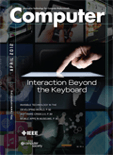
COMPUTER
Shaping Tomorrow's Technology with Rigorous Research.COMPUTER, published by the IEEE COMPUTER SOC, stands as a pivotal resource in the field of computer science, encompassing a broad range of topics and innovations within the industry. With an ISSN of 0018-9162 and E-ISSN 1558-0814, this esteemed journal features high-impact research articles that contribute significantly to the advancement of technology, demonstrating a prestigious Q1 classification in the Computer Science (miscellaneous) category for 2023. Positioned within the top percentile of Scopus rankings (ranked #84 out of 232), COMPUTER serves as an essential platform for sharing pioneering ideas and emerging trends that shape the future of computing. Although it does not currently offer open access, the journal's rigorous peer-review process ensures the publication of high-quality content. Researchers, professionals, and students alike will find invaluable insights into computer science developments from 1970 through 2024, making it a vital tool for anyone dedicated to this ever-evolving field.
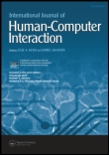
INTERNATIONAL JOURNAL OF HUMAN-COMPUTER INTERACTION
Elevating Human-Centric Design and ResearchINTERNATIONAL JOURNAL OF HUMAN-COMPUTER INTERACTION, published by Taylor & Francis Inc, stands at the forefront of research within the interdisciplinary fields of human-computer interaction, human factors, and ergonomics. Since its establishment, the journal has consistently contributed to advancing the understanding of the interactions between people and computers, making it a vital resource for researchers, professionals, and students alike. With an impressive impact factor reflecting its high citation rate, this journal is recognized as a Q1 publication in both Computer Science Applications and Human Factors and Ergonomics categories for 2023, showcasing its stature within the academic community. Additionally, it boasts a commendable ranking within the top percentiles in key areas on Scopus, ensuring that the research published here reaches broad scholarly audiences. Available in traditional subscription format, the journal covers seminal studies from 1989 to 2024, reflecting ongoing innovation in technology and its applications in everyday life, and thus serves as an essential platform for pioneering research that shapes the future of user experience.
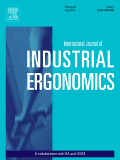
INTERNATIONAL JOURNAL OF INDUSTRIAL ERGONOMICS
Optimizing ergonomics for a safer workplace.INTERNATIONAL JOURNAL OF INDUSTRIAL ERGONOMICS, published by Elsevier, is a premier scholarly outlet dedicated to advancing the fields of human factors and ergonomics, as well as public health, environmental, and occupational health. With an impressive Q2 ranking in both relevant categories, this journal serves as a crucial forum for researchers and professionals seeking to share and access high-quality research aimed at optimizing human performance in industrial settings. The journal has been at the forefront of ergonomic research since its inception in 1986, fostering a rich discourse across disciplines and providing invaluable insights that bridge science and practice. While open access options are not available, the journal is widely accessible through institutional subscriptions. With a Scopus Ranking of #118/665 in Public Health and a #10/46 position in Human Factors, it caters to a diverse audience interested in the latest findings and applications in ergonomics, ensuring its relevance in a rapidly evolving field. Join a community dedicated to enhancing workplace safety and efficacy through rigorous research and innovative methodologies.

Journal on Multimodal User Interfaces
Advancing User Experience Through Multimodal InsightsJournal on Multimodal User Interfaces, published by Springer, serves as a vital platform for scholarly exchange in the rapidly evolving fields of Human-Computer Interaction and Signal Processing. Established in 2008 and continuing through 2024, this journal maintains a high profile in academia, currently ranking in the Q2 category for both fields, indicating its significant contribution to ongoing research and practical applications. With its Scopus rankings placing it at #34 in Signal Processing and #49 in Human-Computer Interaction, it is recognized for publishing high-quality, impactful research. Although it is not an Open Access journal, the Journal on Multimodal User Interfaces remains accessible through institutional subscriptions. Researchers, professionals, and students will find the journal an essential resource for advancing knowledge and fostering collaboration in multimodal interaction technologies, which are crucial for enhancing user experience and developing intelligent systems.

Frontiers in Computer Science
Exploring innovative horizons in computer science research.Frontiers in Computer Science is a premier open-access journal published by Frontiers Media SA that has rapidly established itself as a prominent platform for scholarly research in the diverse and evolving field of computer science. With a notable impact factor reflecting its high citation rates, this journal aims to disseminate innovative findings and groundbreaking studies across multiple subdisciplines, including Computer Science Applications, Computer Vision and Pattern Recognition, and Human-Computer Interaction. Since its inception in 2019, and with a consistent trajectory from 2019 to 2024, it has garnered accolades, achieving Q2 ranking in several categories and an impressive Q1 in miscellaneous areas of computer science. Researchers, professionals, and students alike are encouraged to contribute to this dynamic journal that serves as a vital resource for advancing knowledge and fostering collaborative dialogue in the global computer science community. Frontiers in Computer Science is committed to providing open access to research, promoting unrestricted sharing of ideas and fostering innovation at the intersection of technology and society.

Cognition Technology & Work
Unveiling the Dynamics of Human-Machine InteractionCognition Technology & Work, published by SPRINGER LONDON LTD, is a premier journal dedicated to exploring the multifaceted interactions between cognitive processes and technological applications in various work environments. With an ISSN of 1435-5558 and an E-ISSN of 1435-5566, this journal has established itself as a critical resource for scholars and practitioners in the fields of Computer Science, Human-Computer Interaction, and Philosophy. Evaluated in the 2023 Journal Citation Reports, it holds impressive category quartiles, ranking Q2 in Computer Science Applications and Human-Computer Interaction, and Q1 in Philosophy, highlighting its significant impact in academic discourse. Furthermore, its Scopus rankings showcase its robust standing, particularly within the Arts and Humanities and Computer Science sectors. Adopting a rigorous peer-review process, the journal aims to foster scholarly communication and advancement in the understanding of cognitive influences on technology in the workplace. It serves as an essential platform for researchers, professionals, and students alike, providing insight into innovative methodologies and theoretical frameworks that shape the future of cognitive technology in work settings.

Visual Informatics
Advancing the Future of Visual TechnologyVisual Informatics is a premier academic journal published by Elsevier, dedicated to advancing the fields of computer graphics, computer-aided design, and human-computer interaction. Since its launch in 2017, this Open Access journal has swiftly established itself as a leading platform for innovative research, reflected in its impressive impact factor and robust rankings in various Scopus categories. In 2023, it proudly holds positions in the top quartile (Q1) for Computer Graphics and Computer-Aided Design, Human-Computer Interaction, and Software, showcasing its influential contributions to these dynamic fields. Based in Amsterdam, Netherlands, Visual Informatics encourages the dissemination of high-quality, peer-reviewed articles that explore the intersection of visual technology and user experience, serving as an invaluable resource for researchers, professionals, and students seeking to stay at the forefront of these evolving disciplines.
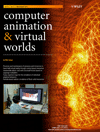
COMPUTER ANIMATION AND VIRTUAL WORLDS
Transforming Ideas into Immersive Experiences.COMPUTER ANIMATION AND VIRTUAL WORLDS, published by Wiley, is a pivotal journal in the fields of Computer Graphics and Computer-Aided Design, as well as Software. With a focus on the intersection of technology and creativity, the journal provides a platform for researchers and professionals to share innovative studies, new methodologies, and insights that shape the future of computer animation and virtual environments. Currently holding a Q2 category in Computer Graphics and a Q3 in Software for 2023, it ranks #63 out of 106 in its niche, highlighting its influence and relevance in the academic community. Though the journal operates under a subscription model, it also offers options for open access, ensuring that a broader audience can engage with groundbreaking research. The journal has been publishing continuously since its inception in 2004 and looks forward to further contributions as it moves towards its 20th anniversary in 2024. Whether you are a seasoned researcher, an industry professional, or a student eager to explore these dynamic fields, COMPUTER ANIMATION AND VIRTUAL WORLDS is an essential resource for advancing knowledge and innovation.